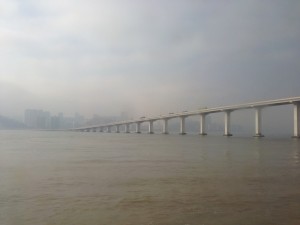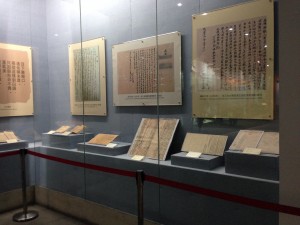Here’s a first post about what I’ve been doing on this long-awaited research trip to China. I’m spending a week in Jiangmen, a weekend in Xinhui and Kaiping, a few days in Zhuhai, a weekend in Panyu and a week in Hong Kong. The trip has been funded by an Australian Academy of the Humanities Travelling Fellowship.

After a day’s travelling from Canberra and a night in Hong Kong on Saturday, I caught the ferry from Tsim Sha Tsui to Jiangmen on Sunday morning. The trip lasts for a bit under three hours and takes you past Macau to Doumen, where the ferry stops briefly, before heading up the river to Jiangmen. I like the ferry — it reminds me of how important water transportation was a century ago and of how my Australian families travelled back to the qiaoxiang, in a series of boats that got smaller and smaller as they got closer to their villages.

The ferry port is some way out of the centre of Jiangmen and with only one taxi on offer (everyone else on the ferry seemed to be met by family or friends), I had a lively exchange with the taxi driver, whose meter was broken and who wanted to charge me a pretty extortionate amount for the half-hour trip. He claimed he wasn’t cheating me, I reckoned he was, but with no other option I hopped in and spent the trip answering his many and varied questions about Australia and why I could speak Chinese. After settling myself into my hotel, on Sunday night I had dinner with Selia Tan from Wuyi University and her university-student daughter. Although it was Sunday, for the university (and everyone else) it had been a work day to make up for the New Year holiday they had been given on Friday.

My main reason for coming to Jiangmen is to visit two villages, one in Xinhui and one in Kaiping, which I will do this coming weekend. But while I’m here I’ve also taken the opportunity to have a look at the Wuyi University Guangdong Qiaoxiang Culture Research Centre library. I’ve spent two happy mornings there, on Monday and Wednesday, muddling through material on Kaiping and Xinhui. It’s a small library, but has collections that focus on each of the Wuyi qiaoxiang districts, as well as more general material on Guangdong. The research centre also publishes material itself, including a new book by Selia Tan on the ornamentation and decoration of qiaoxiang buildings. I am very grateful to Selia for her help in making arrangements for my visit to the research centre.

They have some copies of qiaokan from the 1930s and 1940s, and a more extensive collection starting from the 1980s — but to do serious research into the qiaokan would need lots of time and an improvement in my reading skills, as well as visiting the local library/archives in Xinhui and Kaiping, which is where a fuller collection of qiaokan are kept. The library also contains a range of interesting books on qiaoxiang history and heritage, and in them I’ve found a few leads on Australian things, although nothing directly related to my two villages. I found a book on Chens from Xinhui who went to Australia — and while they weren’t my Chens from Xinhui, they are connected to a family I know someone else at home is researching.


Tuesday morning I visited the Jiangmen Wuyi Museum of Overseas Chinese. The museum tells the history of emigration from Wuyi, starting with nineteenth-century material and progressing through to the current day. Some of the highlights for me were:
- contracts for borrowing money to pay for emigration
- a shipping notice for ships travelling to Australia
- coaching books and papers
- seeing dear old Quong Tart, and William Liu, among the notable Chinese pioneers (but what of the likes of other Sze Yup notables like Yee Wing or Lowe Kong Meng?)
- remittance letters
- a photograph of a bus in 1929, and a life-size version of said bus that you can climb into!
The museum gives a nice overview of the history and is definitely worth a visit. The text panels and item labels are all bilingual. The museum guards on duty were a very jovial lot and I was just about the only visitor there.

On Tuesday afternoon I gave a talk at the research centre on Australian Chinatowns and the Chinese heritage of southern Australia. After walking to the uni in good time to set up my slides and whatnot, I realised that I’d left my handwritten notes behind in the hotel. Luckily my lovingly prepared 100+ slides saved the day! Selia Tan translated as I spoke, and we finished up after more than two hours of talking. It wasn’t a huge group, about 25 in all, made up of staff and students from the research centre, other students who were just interested to come along and hear, and a group from Xinhui who are interested in my work on Shiquli village (more on that in another post, I think). Also in attendance was a local journalist and to my surprise the front page of Wednesday’s newspaper featured my talk, with a small article inside. After the talk I went to dinner with Dorry Chen, also from Shiquli village, who is going to take me there on the weekend. She is a teacher in an international kindergarten here in Jiangmen.
The next couple of days are going to be a bit quieter, with just a short visit to a village here in Jiangmen today and some time to read and work on my DECRA application.